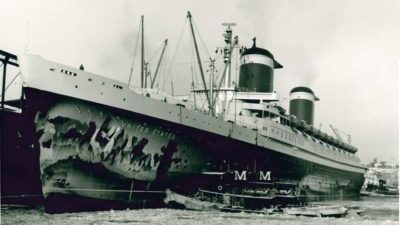
FreightWaves Classics is sponsored by Sutton Transport, an LTL leader in the Midwest for more than 40 years. Sutton Transport proudly services Illinois, Minnesota, Missouri and Wisconsin. Request a quote here.
For almost 100 years, United States Lines was the premier American carrier on the North Atlantic.
Its fleet of liners were continually in the headlines. In the company’s heyday, the Leviathan was the largest ship in the world; the United States was the fastest; its Challenger I class were the fastest cargo ships; the Challenger IIs were the first keel-up-built container ships; and, finally, the 12 Econ ships of the 1980s were the largest container ships in the world, carrying 4,614 twenty-foot containers.
U.S. Lines’ ships took part in many of the famous rescues of their times. President Theodore Roosevelt rescued all the personnel from the sinking British grain ship Antinoe in 1926, and the American Shipper was the primary rescue ship during the 1928 sinking of the liner Vestris.

Although its lavish passenger fleet garnered most of the headlines, the company maintained a large fleet of cargo liners that bore the prefix American, followed by a trade-related name such as Farmer, Merchant, Banker or Shipper. Typical for these generations of cargo liners was the name American Shipper.
The first American Shipper was one of the so-called “Hog Island” transports that were built at Hog Island, the present-day location of the Philadelphia International Airport. This vessel was one of 122 constructed by the American International Shipbuilding Co. during World War I and delivered to the U.S. government in 1920 under the name Tours.
In May 1926, the vessel commenced its first commercial voyage as the American Shipper, the last of five sister ships assigned to the company. These ships could carry 90 passengers, as well as 8,000 tons of refrigerated and general cargo. Although they were the smallest passenger-cargo liners on the North Atlantic, the vessels were well received by passengers and cargo shippers alike.
In November 1939, in response to the war in Europe, Congress passed the Neutrality Act, which forbade U.S. ships access to warring nations. This was the formal end of U.S. liner service to Europe.
In 1940, the five sister ships were sold to Societe Maritime Anversoise and placed under the Belgian flag. The American Shipper was renamed Ville De Mons and sunk by enemy action shortly thereafter.

American Shipper II
In 1938, the U.S. Maritime Commission and U.S. Lines, believing there would be a resurgence of American-European trade after peace was achieved, contracted with Ingalls Shipyard in Pascagoula, Mississippi, to replace the Hog Island ships with four C3-P-type passenger-cargo liners.
However, after the first keel was set, it was obvious World War II would not be over soon, so the ship was sold to Farrell Lines for use in South African service. The vessel was launched as the African Meteor in 1942.
As the vessel’s delivery date approached, the U.S. Navy required transports. Upon delivery in February 1943, the vessel bore the name USS Samuel Chase (AP56). After a long military career, the vessel was scrapped at Brownsville, Texas, in 1973.

American Shipper III
Thinking the war in Europe would end shortly, U.S. Lines tried again in 1941 for another American Shipper and three sister ships for North Atlantic service.
Once again, the U.S. military stepped in and the ship was launched as the transport Pass Christian and completed as the Army transport Fred C. Ainsworth in June 1943. The ship was later transferred to and operated by the navy until its scrapping at Kaohsiung, Taiwan, in 1963.
Neither the second or third American Shipper made a commercial voyage, although both served the country gallantly for many years.
American Shipper IV
In December 1945, an American Shipper was delivered to U.S. Lines from a shipyard at Wilmington, North Carolina, for use on the North Atlantic.

The vessel had about 40 sister ships instead of the four earlier in the century. These C2-type ships carried 12 passengers but were primarily cargo liners with a capacity of 10,400 tons. This American Shipper plied the Atlantic trades for 23 years before being sold in 1968.
This story of the American Shipper vessel lineage is fitting since this website dedicated to those interests bears the same name.
U.S. Lines, which traces its roots to 1872, has operated under various names and owners. It boasted many liners and cargo ships in the 1920s and ’30s and hundreds more during World War II. The longtime headquarters was located at One Broadway in New York City.
Although U.S. Lines benefited from a good head start in the containership era, competition from SeaLand Service, and later foreign operators, spelled the end for this once-great company. It filed bankruptcy in 1986 and the fleet was auctioned off shortly thereafter.
Capt. James McNamara, who is retired as president of the National Cargo Bureau, currently serves as historian of the Maritime Industry Museum at Fort Schuyler, N.Y., and remains active in the maritime industry.
FreightWaves Classics articles look at various aspects of the transportation industry’s history. If there are topics that you think would be of interest, please send them to [email protected]












T J Smith
From – [email protected]
Re SS AMERICAN SHIPPER IV – I was working in USL Phila office during 1950s – I remember the Master was a Captain Warren Woodman – he had a strong resemblance to the mayor of Phila. Brernard Samuel. I escorted the Master to the Customs House to enter and clear his ship after he was up all night navigating the eight hour run up the Delaware River. These C2 vessels were uSL workhorses post WWII on the North Atlantic. USL demise 36 years ago was not caused by Sealand competition rather by McLean round the world expansion and decline in freight rates.